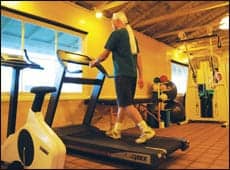A new low-cost, portable EEG brain-computer interface that connects the brain of stroke patients to powered exoskeletons for rehabilitation purposes has been validated and tested at the University of Houston.
“We designed and validated a wireless, easy-to-use, mobile, dry-electrode headset for scalp electroencephalography (EEG) recordings for closed-loop brain–computer (BCI) interface and internet-of-things (IoT) applications,” report professor Jose Luis Contreras-Vidal, Hugh Roy, and Lillie Cranz Cullen Distinguished Professor of electrical and computer engineering, in the journal Sensors. Contreras-Vidal is an international pioneer in noninvasive brain-machine interfaces and robotic device inventions.
An EEG-based brain-computer interface (BCI) is a system that provides a pathway between the brain and external devices by interpreting EEG. In other words, the device reads your mind, interpreting the brain’s activity to initiate robotic movement. Brain-machine interfaces based on scalp EEG also have the potential to promote cortical plasticity following stroke, which has been shown to improve motor recovery outcomes.
The adjustable headset, designed from commercial off-the-shelf components, can accommodate 90% of the population. There is a patent pending on both the BCI algorithm and the self-positioning dry electrode bracket allowed for vertical self-positioning while parting the user’s hair to ensure contact of the electrode with the scalp.
“We used a multi-pronged approach that balanced interoperability, cost, portability, usability, form factor, reliability, and closed-loop operation,” says Contreras-Vidal.
In the current prototype, five EEG electrodes were incorporated in the electrode bracket spanning the sensorimotor cortices and three skin sensors were included to measure eye movement and blinks. An inertial movement unit, measuring head motion, allows for a portable brain-body imaging system for BCI applications.
“Most commercial EEG-based BCI systems are tethered to immobile processing hardware or require complex programming or set-up, making them difficult to deploy outside of the clinic or laboratory without technical assistance or extensive training. A portable and wireless BCI system is highly preferred so it can be used outside lab in clinical and non-clinical mobile applications at home, work, or play,” says Contreras-Vidal.
The invention was designed to solve an array of needs.
“Current commercial EEG amplifiers and BCI headsets are prohibitively expensive, lack interoperability, or fail to provide a high signal quality or closed-loop operation, which are vital for BCI applications,” Contreras-Vidal says.
About the University of Houston
The University of Houston is a Carnegie-designated Tier One public research university recognized with a Phi Beta Kappa chapter for excellence in undergraduate education. UH serves the globally competitive Houston and Gulf Coast Region by providing world-class faculty, experiential learning, and strategic industry partnerships. Located in the nation’s fourth-largest city and one of the most ethnically and culturally diverse regions in the country, UH is a federally designated Hispanic- and Asian-American-Serving institution with enrollment of more than 47,000 students.





